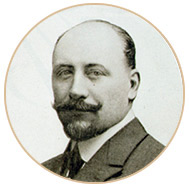Marc Birkigt
Marc Birkigt (born March 8, 1878 in Geneva , † March 15, 1953 in Versoix ) was a Swiss designer. He became known for founding the Hispano-Suiza company . Birkigt was the son of the German Ernst Ludwig Birkigt and Louise Annen.
Birkigt lost his parents at an early age and was raised by his grandmother. In 1898 he received the Geneva homeland law and graduated from the Ecole de mécanique there . When his grandmother died, nothing kept him in Switzerland and he went to Barcelona in 1899 , where he initially designed an electric bus for the truck manufacturer La Cuadra . There he began to design an internal combustion engine and finally developed a completely new type of car for which he designed the chassis, engine and power transmission. Despite this, this company went bankrupt, after which he moved back to Geneva.
There he married Eugénie Maria Brachet on November 23, 1901, with whom he had the son Louis (* 1903, † 1979) and the daughter Yvonne (* 1905). Louis Birkigt's only child, Marc Louis Emile Birkigt, born in 1931, was killed in a plane crash in June 1950.
The main creditor of La Cuadra, the banker Juan Castro, asked Birkigt in November 1902 to come back to Barcelona to set up a new automobile production facility. Castro and Birkigt founded J. Castro Sociedad en Comandita , Fábrica Hispano-Suiza de Automóviles as a partner . Birkigt developed the cardan shaft and used it in Castro vehicles. This company also went bankrupt at the end of 1903, and production ended in 1904 after only eight cars had been built.
Francisco Seix Zaya and the lawyer Damiá Mateu stepped in and founded the company Hispano-Suiza, Fabrica de automoviles SA in Barcelona on June 14, 1904 , with Birkigt as co-owner and chief designer. Even the young King of Spain, Alfonso XIII, who was a motor enthusiast . stood behind the start-up. The Hispano-Suiza vehicles were extremely expensive and sales stagnated. Sales offices were set up in Paris and Geneva in order to reach wealthy customers. The 1906 Paris Motor Show was the breakthrough for Hispano-Suiza and its chief designer, Birkigt.
In addition to the automotive industry, Marc Birkigt also dealt with the construction of aircraft engines from 1914 , was chief designer of the SPAD company and in the 1930s also developed aircraft on-board weapons such as the ( machine cannon HS.404 ). Two years after the start of the Spanish Civil War he left Spain and founded in 1938 in Geneva , the Hispano-Suiza (Suisse) SA , the smaller weapon systems and tools produced. With his son Louis Birkigt as sole owner of the Swiss group was in the late 1960s in the HS-30 scandal to the procurement of the armored personnel carrier HS 30 for the armed forces involved.
For his life's work, Birkigt was made a Grand Officer of the French Legion of Honor (1939) and an honorary doctorate from the ETH Zurich . He filed over 150 patents.
literature
- Manuel Lage, SJ Sanchez-Peredo, M. Viejo: Hispano-Suiza in Aeronautics: men, companies, engines & aircrafts . Ed. Society of Automotive Engineers, 11, 2003, USA.
Web links
- Hispano-Suiza company history on hispano-suiza-sa.com (English / French)
- Jean de Senarclens: Birkigt, Marc. In: Historical Lexicon of Switzerland .
- Publications by and about Marc Birkigt in the Helveticat catalog of the Swiss National Library
Individual evidence
- ↑ Louis Birkigt.
- ↑ Marc Birkigt - Marc Hauenstein on aerosteles.net, accessed on February 9, 2016
| personal data | |
|---|---|
| SURNAME | Birkigt, Marc |
| BRIEF DESCRIPTION | Swiss designer |
| DATE OF BIRTH | March 8, 1878 |
| PLACE OF BIRTH | Geneva |
| DATE OF DEATH | March 15, 1953 |
| Place of death | Versoix |


